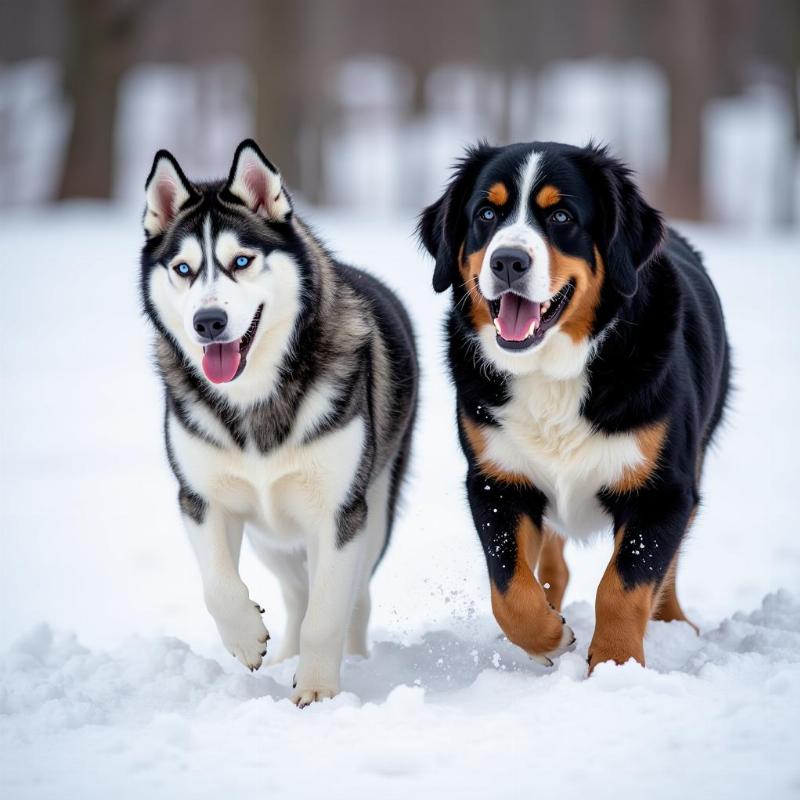Keeping your furry friend safe and happy during the snowy months is a top priority for any dog owner. Knowing how long dogs can tolerate the cold is crucial to prevent hypothermia and frostbite. While some breeds thrive in winter wonderlands, others need extra protection from the elements. So, how long can dogs be in snow? The answer isn’t a simple one-size-fits-all. It depends on several factors including breed, size, coat thickness, age, and the overall weather conditions.
Factors Influencing a Dog’s Tolerance to Snow
A husky frolicking in a blizzard paints a picturesque image, but not all dogs are built for such extreme conditions. Smaller dogs, short-haired breeds, puppies, and senior dogs are more susceptible to the cold and should have limited exposure to snow and icy temperatures. Larger dogs with thick double coats, like Bernese Mountain Dogs or Saint Bernards, are generally better equipped to handle colder weather. However, even these breeds have their limits.
Breed and Coat Type: A Natural Defense
A dog’s breed and coat are significant factors in determining their cold tolerance. Breeds like Siberian Huskies and Alaskan Malamutes, bred for sledding in sub-zero temperatures, have thick, insulating double coats that protect them from the harsh elements. Conversely, Chihuahuas and Greyhounds, with their thin coats, are much more vulnerable to the cold.
 Dogs with thick coats in the snow
Dogs with thick coats in the snow
Age and Health: Special Considerations
Puppies and senior dogs have weaker immune systems and are more susceptible to hypothermia. Their bodies regulate temperature less efficiently than adult dogs. Similarly, dogs with underlying health conditions, such as heart disease or diabetes, may also have difficulty regulating their body temperature and should be monitored closely in cold weather.
Weather Conditions: Beyond Just Snow
The air temperature, wind chill, and humidity all play a role in how long a dog can safely be in the snow. A damp, windy day at 30°F feels much colder than a dry, calm day at the same temperature. Consider these factors when deciding how long your dog can stay outside.
Signs Your Dog is Too Cold
It’s vital to recognize the signs of hypothermia in dogs. Shivering, whining, lethargy, and slowed breathing can all indicate that your dog is getting too cold. If you observe any of these signs, bring your dog inside immediately and warm them up slowly. Contact your veterinarian if your dog’s condition doesn’t improve.
Preventing Cold-Weather Dangers
Taking proactive steps can help prevent cold-weather related problems. Consider investing in dog booties for sled dogs to protect your dog’s paws from ice and snow. A fido fleece coats for dogs can provide an extra layer of warmth, especially for short-haired breeds. If your dog spends time outdoors in a dog house, ensure it’s insulated and equipped with a dog heating pad for dog house and a plastic flap for dog house to keep out the wind and snow.
Conclusion: Prioritizing Your Dog’s Safety in the Snow
How long can dogs be in snow? There’s no magic number. Always prioritize your dog’s safety and comfort. Monitor them closely for signs of distress, and be prepared to bring them inside if necessary. By understanding your dog’s individual needs and taking appropriate precautions, you can ensure they enjoy the winter wonderland safely and comfortably.
FAQ
- How can I tell if my dog is too cold? Shivering, whining, lethargy, and slowed breathing are signs your dog is too cold.
- Do all dogs need winter coats? Short-haired breeds and smaller dogs benefit greatly from winter coats in cold weather.
- What kind of dog house is best for winter? An insulated dog house with a raised floor and a wind-blocking door flap is ideal.
- Are there any breeds that can tolerate extreme cold? Breeds like Huskies and Malamutes are adapted to cold weather, but even they have limits.
- What should I do if my dog gets hypothermia? Bring your dog inside immediately, warm them slowly, and contact your veterinarian.
- Can I leave my dog outside in the snow overnight? It’s generally not recommended, especially for smaller or short-haired breeds. Even cold-hardy breeds need adequate shelter.
- How can I protect my dog’s paws in the snow? Dog booties can protect paws from ice, snow, and salt.
Beautdogs.us is your premier resource for all things dog-related in the US. We offer expert advice on dog breeds, care, and products, catering to both new and experienced dog owners. From choosing the right extra large insulated outdoor dog house to understanding breed-specific needs, Beautdogs.us is your trusted companion on your dog ownership journey. Contact us today for all your dog-related inquiries! Email: [email protected], Phone: +1 501-555-7529.